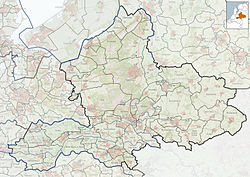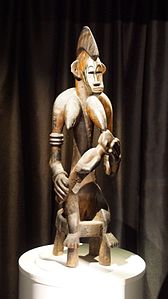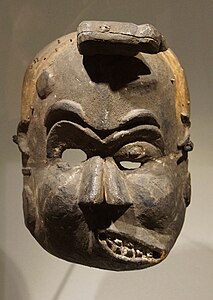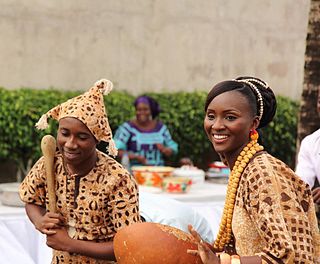
The Senufo people, also known as Siena, Senefo, Sene, Senoufo, and Syénambélé, are a West African ethnolinguistic group. They consist of diverse subgroups living in a region spanning the northern Ivory Coast, the southeastern Mali and the western Burkina Faso. One sub-group, the Nafana, is found in north-western Ghana.

The Museum of Anthropology at the University of British Columbia (UBC) campus in Vancouver, British Columbia, Canada displays world arts and cultures, in particular works by First Nations of the Pacific Northwest. As well as being a major tourist destination, MOA is a research and teaching museum, where UBC courses in art, anthropology, archaeology, conservation, and museum studies are given. MOA houses close to 50,000 ethnographic objects, as well as 535,000 archaeological objects in its building alone.

The Dogon are an ethnic group indigenous to the central plateau region of Mali, in West Africa, south of the Niger bend, near the city of Bandiagara, and in Burkina Faso. The population numbers between 400,000 and 800,000. They speak the Dogon languages, which are considered to constitute an independent branch of the Niger–Congo language family, meaning that they are not closely related to any other languages.

African art describes the modern and historical paintings, sculptures, installations, and other visual culture from native or indigenous Africans and the African continent. The definition may also include the art of the African diasporas, such as: African-American, Caribbean or art in South American societies inspired by African traditions. Despite this diversity, there are unifying artistic themes present when considering the totality of the visual culture from the continent of Africa.

The Royal Museum for Central Africa (RMCA), communicating under the name AfricaMuseum since 2018, is an ethnography and natural history museum situated in Tervuren in Flemish Brabant, Belgium, just outside Brussels. It was originally built to showcase King Leopold II's Congo Free State in the International Exposition of 1897.
The diverse culture of Ivory Coast, a coastal West African country bordered by Ghana, Liberia, Mali, Burkina Faso, and Guinea, is exemplified by a multitude of ethnic groups, events, festivals, music, and art.

The National Museum of African Art is the Smithsonian Institution's African art museum, located on the National Mall of the United States capital. Its collections include 9,000 works of traditional and contemporary African art from both Sub-Saharan and North Africa, 300,000 photographs, and 50,000 library volumes. It was the first institution dedicated to African art in the United States and remains the largest collection. The Washington Post called the museum a mainstay in the international art world and the main venue for contemporary African art in the United States.
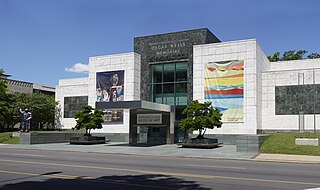
The Birmingham Museum of Art is a museum in Birmingham, Alabama. Its collection includes more than 24,000 paintings, sculptures, prints, drawings, and decorative arts representing various cultures, including Asian, European, American, African, Pre-Columbian, and Native American. The museum is also home to some Renaissance and Baroque paintings, sculptures,and decorative arts from the late 13th century to c. 1750.

The Museum Five Continents or Five Continents Museum, located in Munich, Germany, is a museum for non-European artworks and objects of cultural value. Its name until 9 September 2014 was Bavarian State Museum of Ethnology.

The Musée du Quai Branly – Jacques Chirac, located in Paris, France, is a museum designed by French architect Jean Nouvel to feature the indigenous art and cultures of Africa, Asia, Oceania, and the Americas. The museum collection comprises more than a million objects, of which 3,500 are on display at any given time, in both permanent and temporary thematic exhibits. A selection of objects from the museum is also displayed in the Pavillon des Sessions of the Louvre.

The Fowler Museum at UCLA, commonly known as The Fowler, and formerly Museum of Cultural History and Fowler Museum of Cultural History, is a museum on the campus of the University of California, Los Angeles (UCLA) which explores art and material culture primarily from Africa, Asia and the Pacific, and the Americas, past and present.

The Museum of Vancouver (MOV) is a civic history museum located in Vanier Park, Vancouver, British Columbia. The MOV is the largest civic museum in Canada and the oldest museum in Vancouver. The museum was founded in 1894 and went through a number of iterations before being rebranded as the Museum of Vancouver in 2009. It creates Vancouver-focused exhibitions and programs that encourage conversations about what was, is, and can be Vancouver. It shares an entrance and foyer with the H. R. MacMillan Space Centre but the MOV is much larger and occupies the vast majority of the space in the building complex where both organisations sit as well as separate collections storage facilities in another building.
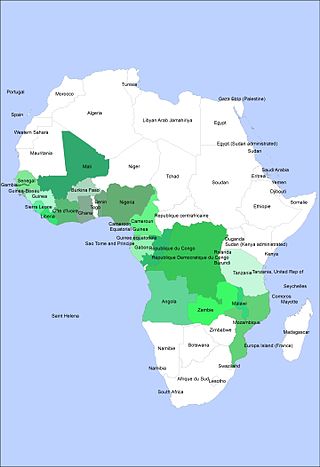
Traditional African masks play an important role in ceremonies, rituals, and masquerades across West, Central, and Southern Africa. Ceremonies in which masks are worn include harvest celebrations, funerals, rites of passage, weddings, and coronations. In some societies, masks and masquerades are also used to settle disputes and communal conflicts.

Most African sculpture was historically in wood and other organic materials that have not survived from earlier than at most a few centuries ago; older pottery figures are found from a number of areas. Masks are important elements in the art of many peoples, along with human figures, often highly stylized. There is a vast variety of styles, often varying within the same context of origin depending on the use of the object, but wide regional trends are apparent; sculpture is most common among "groups of settled cultivators in the areas drained by the Niger and Congo rivers" in West Africa. Direct images of African deities are relatively infrequent, but masks in particular are or were often made for traditional African religious ceremonies; today many are made for tourists as "airport art". African masks were an influence on European Modernist art, which was inspired by their lack of concern for naturalistic depiction.
The Songye people, sometimes written Songe, are a Bantu ethnic group from the central Democratic Republic of the Congo. They speak Songe language. They inhabit a vast territory between the Sankuru/Lulibash river in the west and the Lualaba River in the east. Many Songye villages can be found in present-day East Kasai province, parts of Katanga and Kivu Province. The people of Songye are divided into thirty-four conglomerate societies; each society is led by a single chief with a Judiciary Council of elders and nobles (bilolo). Smaller kingdoms east of the Lomami River refer to themselves as Songye, other kingdoms in the west, refer to themselves as Kalebwe, Eki, Ilande, Bala, Chofwe, Sanga and Tempa. As a society, the people of Songye are mainly known as a farming community; they do, however, take part in hunting and trading with other neighboring communities.
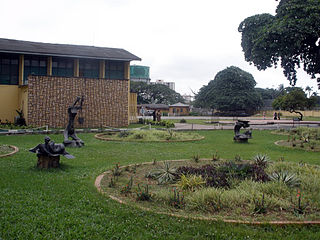
The Nigerian National Museum is a national museum of Nigeria, located in the city of Lagos. The museum has a notable collection of Nigerian art, including pieces of statuary, carvings also archaeological and ethnographic exhibits. Of note is a terracotta human head known as the Jemaa Head, part of the Nok culture. The piece is named after Jema'a, the village where it was discovered. The museum is located at Onikan, Lagos Island, Lagos State. The museum is administered by the National Commission for Museums and Monuments.

The Afrika-Haus Freiberg is a museum of modern African art at Freiberg am Neckar in Germany.
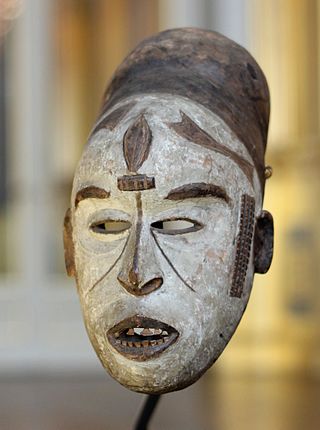
Some African objects had been collected by Europeans for centuries, and there had been industries producing some types, especially carvings in ivory, for European markets in some coastal regions. Between 1890 and 1918 the volume of objects greatly increased as Western colonial expansion in Africa led to the removal of many pieces of sub-Saharan African art that were subsequently brought to Europe and displayed. These objects entered the collections of natural history museums, art museums and private collections in Europe and the United States. About 90% of Africa's cultural heritage is believed to be located in Europe, according to French art historians.

The Museum der Völker in the Austrian Schwaz in the county of Tyrol was founded in 1995 as a cultural association Haus der Völker by Gert Chesi and belongs to the well known Ethnology museums in Europe. After a new construction and remodeling the exhibition operation opened on the 12th of April 2013 as Museum der Völker. Translated the name means museum of the peoples or museum of the tribes.

Awa, also known as the Awa Society, the Society of Masks, is an African mask and initiatory society of the Dogon people of Mali which is made up of circumcised men, and whose role is both ritual and political within Dogon society. The Awa Society takes an important role in Dogon religious affairs, and regularly preside over funereally rites and the dama ceremony—a ritual ceremony that marks the end of bereavement in Dogon country. This Society is one of the important aspect of Dogon religious life—which is primarily based on the worship of the single omnipotent, omniscient and omnipresent Creator God Amma and the veneration of the ancestors. Although it is only one aspect of Dogon's religious sects, it is perhaps more well known than the others partly due to Dogon mask–dance culture which attracts huge tourism, and their masks highly sought after, and in fact, one of the first to be sought after by art collectors in the west.


